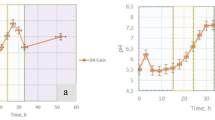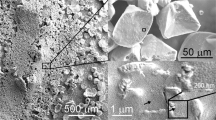Abstract
Coccolithophorids, unicellular marine microalgae, have calcified scales with elaborate structures, called coccoliths, on the cell surface. Coccoliths generally comprise a base plate, CaCO3, and a crystal coat consisting of acidic polysaccharides. In this study, the in vitro calcification conditions on the base plate of Pleurochrysis haptonemofera were examined to determine the functions of the base plate and acidic polysaccharides (Ph-PS-1, -2, and -3). When EDTA-treated coccoliths (acidic polysaccharide-free base plates) or low pH-treated coccoliths (whole acidic polysaccharide-containing base plates) were used, mineralization was not detected on the base plate. In contrast, in the case of coccoliths which were decalcified by lowering of the pH and then treated with urea (Ph-PS-2-containing base plates), distinct aggregates, probably containing CaCO3, were observed only on the rim of the base plates. Energy dispersive X-ray spectroscopy (EDS) confirmed that the aggregates contained Ca and O, although X-ray diffraction analysis did not reveal any evidence of crystalline materials. Also, in vitro mineralization experiments performed on EDTA-treated coccoliths using isolated acidic polysaccharides demonstrated that the Ca-containing aggregates were markedly formed only in the presence of Ph-PS-2. Furthermore, in vitro mineralization experiments conducted on protein-extracted base plates suggested that the coccolith-associated protein(s) are involved in the Ca deposition. These findings suggest that Ph-PS-2 associated with the protein(s) on the base plate rim initiates Ca2+ binding at the beginning of coccolith formation, and some other factors are required for subsequent calcite formation.







Similar content being viewed by others
References
Borman AH, de Jong EW, Huizinga M, Kok DJ, Westbroek P, Bosch L (1982) The role in CaCO3 crystallization of an acid Ca2+-binding polysaccharide associated with coccoliths of Emiliania huxleyi. Eur J Biochem 129:179–183
de Jong EW, Bosch L, Westbroek P (1976) Isolation and characterization of a Ca2+-binding polysaccharide associated with coccoliths of Emiliania huxleyi (Lohmann) Kamptner. Eur J Biochem 70:611–621
Fichtinger-Schepman AMJ, Kamerling JP, Versluis C, Vliegenthart JFG (1981) Structural studies of the methylated, acidic polysaccharide associated with coccoliths of Emiliania huxleyi (Lohmann) Kamptner. Carbohydr Res 93:105–123
Fujiwara S, Tsuzuki M (2011) Coccolith formation in the Haptophyta. In: Kersey WT, Munger SP (eds) Marine phytoplankton. Nova Science Publishers, New York
Fujiwara S, Hirokawa Y, Takatsuka Y, Suda K, Asamizu E, Takayanagi T, Shibata D, Tabata S, Tsuzuki M (2007) Gene expression profiling of coccolith-bearing cells and naked cells in haptophyte Pleurochrysis haptonemofera with a cDNA macroarray system. Mar Biotechnol 9:550–560
Gal A, Wirth R, Kopka J, Fratzl P, Faivre D, Scheffel A (2016) Macromolecular recognition directs calcium ions to coccolith mineralization sites. Science 353:590–593
Gal A, Wirth R, Barkay Z, Eliaz N, Scheffel A, Faivre D (2017) Templated and self-limiting calcite formation directed by coccolith organic macromolecules. Chem Commun 53:7740–7743
Hirokawa H, Fujiwara S, Tsuzuki M (2005) Three types of acidic polysaccharides associated with coccolith of Pleurochrysis haptonemofera: comparison of the biochemical characteristics with those of P. carterae and analysis using fluorescein-isothiocyanate-labeled lectins. Mar Biotechnol 7:634–644
Hirokawa Y, Matsuzuka S, Itayama S, Uchida T, Fujiwara S, Ozaki N, Nagasawa H, Tsuzuki M (2013) Localization and associative strength of acid polysaccharides in coccoliths of Pleurochrysis haptonemofera (Haptophyta) predicted from their extractability from partially decalcified coccoliths. Open J Mar Sci 3:48–54
Kayano K, Saruwatari K, Kogure T, Shiraiwa Y (2011) Effect of coccolith polysaccharides isolated from the coccolithophorid, Emiliania huxleyi, on calcite crystal formation in in vitro CaCO3 crystallization. Mar Biotechnol 13:83–92
Marsh ME (2003) Regulation of CaCO3 formation in coccolithophores. Comp Biochem and Physiol B 136:743–754
Marsh ME, Dickinson DP (1997) Polyanion-mediated mineralization—mineralization in coccolithophore (Pleurochrysis carterae) variants which do not express PS2, the most abundant and acidic mineral-associated polyanion in wild-type cells. Protoplasma 199:9–17
Marsh ME, Chang DK, King GC (1992) Isolation and characterization of a novel acidic polysaccharide containing tartrate and glyoxylate residues from the mineralized scales of a unicellular coccolithophorid alga Pleurochrysis carterae. J Biol Chem 267:20507–20512
Marsh ME, Ridall AL, Azadi P, Duke PJ (2002) Galacturonomannan and Golgi-derived membrane linked to growth and shaping of biogenic calcite. J Struct Biol 139:39–45
Ozaki N, Sakuda S, Nagasawa H (2001) Isolation and some characterization of an acidic polysaccharide with anti-calcification activity from coccoliths of a marine alga, Pleurochrysis carterae. Biosci Biotechnol Biochem 65:2330–2333
Ozaki N, Ikazaki M, Kogure T, Sakuda S, Nagasawa H (2004) Structural and functional diversity of acidic polysaccharides from various species of coccolithophorid algae. Thalassas 20:61–70
Paasche E (2002) A review of the coccolithophorid Emiliania huxleyi (Prymnesiophyceae), with particular reference to growth, coccolith formation, and calcification-photosynthesis interactions. Phycologia 40:503–529
Patton J, Reeder W (1956) New indicator for titration of calcium with (ethylenedinitrilo) tetraacetate. Anal Chem 28:1026–1028
Shiraiwa Y (2003) Physiological regulation of carbon fixation in the photosynthesis and calcification of coccolithophorids. Comp Biochem and Physiol B Biochem Mol Biol 136:775–783
Smith BL, Paloczi GT, Hansma PK, Levine RP (2000) Discerning nature’s mechanism for making complex biocomposite crystals. J Crystal Growth 211:116–121
Takahashi J, Fujiwara S, Kikyo M, Hirokawa Y, Tsuzuki M (2002) Discrimination of the cell surface of the coccolithophorid Pleurochrysis haptonemofera from light scattering and fluorescein-isothiocyanate-labeled lectin staining measured by flow cytometry. Mar Biotechnol 4:94–101
Young JR, Didymus JM, Bown PR, Prins B, Mann S (1992) Crystal assembly and phylogenetic evolution in heterococcoliths. Nature 356:516–518
Acknowledgements
We are grateful to Dr. I. Inouye of Tsukuba University for kindly providing the P. haptonemofera cells, to Drs. Y. Hirokawa of Tokyo University of Pharmacy and M. Kawachi of NIES for the excellent scanning electron micrographs of the cells and hearty encouragement, and to Mr. N. J. Halewood for correcting the English version of this paper.
Funding
This work was supported by a Grant-in-Aid from the Ministry of Education, Science, Sports and Culture, Japan (16 K07427), and the Promotion and Mutual Aid Corporation for Private Schools.
Author information
Authors and Affiliations
Corresponding author
Ethics declarations
Conflict of Interest
The authors declare that they have no conflict of interest.
Rights and permissions
About this article
Cite this article
Sakurada, S., Fujiwara, S., Suzuki, M. et al. Involvement of Acidic Polysaccharide Ph-PS-2 and Protein in Initiation of Coccolith Mineralization, as Demonstrated by In Vitro Calcification on the Base Plate. Mar Biotechnol 20, 304–312 (2018). https://doi.org/10.1007/s10126-018-9818-4
Received:
Accepted:
Published:
Issue Date:
DOI: https://doi.org/10.1007/s10126-018-9818-4




